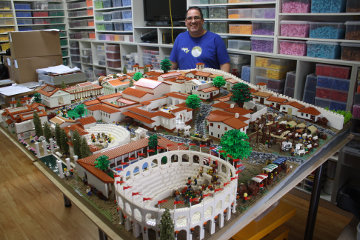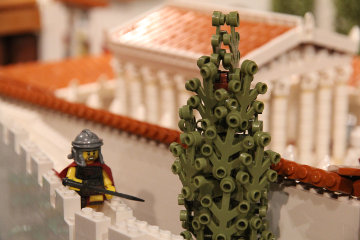Rebuilding Pompeii
| Pompeii Amphitheatre | 40 45 04.79N 14 29 42.57E | The oval amphitheatre is clearly visible, with the barracks adjoining to the south-west. |
| The Nicholson Museum | 33 53 11.26S 151 11 20.09E | According to Google Earth, this is where you will find the Nicholson Museum. |
Several times over the years we have reported on the accelerating decay of Pompeii, the ancient Roman city destroyed by Vesuvius, excavated by archaeologists and now being allowed to crumble away by the Italian government. It is nice, therefore, to be able to report on a project whose aim is to rebuild Pompeii brick by brick - Lego brick by Lego brick!

| |
| Ryan McNaught proudly surveys his impression of what Pompeii may have looked like in AD 79. |
The University of Sydney's Nicholson Museum has embraced the idea of using Lego to recreate ancient sites with enthusiasm. In 2012 they rebuilt the Colosseum in Lego and the following year they rebuilt the Acropolis (rather faster than the Greeks are rebuilding the real thing!) In 2014 they set their eyes on Pompeii and commissioned Ryan McNaught, who is a certified Lego professional - I didn't even know there were such creatures! - to do the actual building work.
It took him five hundred hours of playing with Lego and more than 190,000 individual bricks, but the result is impressive. As you might expect, even with that many bricks, he has not managed to recreate the whole of Pompeii, nor is his model 100% accurate, but it is a worthy attempt to bring ancient Pompeii to life.
An example of inaccuracy is the amphitheatre, which is unique - or so I believe - in having external staircases and a broad promenade from which patrons entered the upper reaches of the seating. Mr McNaught has built a generic amphitheatre which has more in common with the Colosseum than with Pompeii! (And in case anyone wants to quibble, there is only one amphitheatre in Pompeii and the gladiators' barracks are right beside it, as the Lego model depicts. It would, I think, be more accurate to say that the museum has created an impression of Pompeii rather than a model of Pompeii.

| |
| Dr Craig Barker on the left and Michael Turner, senior curator of the Nicholson Museum, survey the finished model. |

| |
| The amphitheatre at Pompeii, seen from the air. Note the wide promenade around the upper part, and the external staircase at bottom left. |
Dr Craig Barker, the Manager of Education and Public Programmes has written a piece to explain the thinking behind the model, entitled, "Lego Pompeii creates less pomp and more yay in the museum", in which he states,
From personal experience I have seen children engrossed in the Lego display, but then actually spend far longer exploring the collection as a whole. Education and entertainment need not be mutually exclusive in a museum.
That is no doubt very commendable, but even so I question the necessity to include a figure of Pink Floyd, just because he once performed in the amphitheatre, or to place Mozart in the temple of Isis on the basis that someone, somewhere, claimed that he drew his inspiration for "The Magic Flute" from that temple.
Equally imaginative but a good deal more authentic are the "Roman" figures that dot the scene. A gladiator swims in the pool in his barracks, stall holders cry their wares outside the amphitheatre, a sparse audience waits for a literary production to take place in the Odeon, and so on. There are bakeries and bars, temples with priests and carters driving wagons along the streets. The forum is lined with temples and other buildings, but instead of the famous "boxer" - the god Apollo in a pugilistic pose - Mr McNaught has inserted a figure on a prancing horse, which I rather suspect is a mediaeval knight with his surcoat painted white. Really, in these days of 3D printers, I do think Mr McNaught could have done better!

| |
| The forum is, quite correctly, flanked by temples, but I rather suspect that a close inspection of the figure on the prancing horse will show that he is a Lego knight in mediaeval armour! |
According to the museum's press release, the model is intended to depict three phases of Pompeii's history; the way the city looked in AD 79 before Vesuvius got at it, the way it looked in the 18th century when the city was first discovered, and finally the way the city looks today. There are what appear to be tourists standing beneath the prancing horse in the forum (but on the other hand, they could be characters from Dr Who, who does feature in the the model), but unfortunately, none of the photographs supplied to me by the museum show how the 18th century is depicted.
In a way I have a certain sympathy for Dr Barker. The iPad generation are probably not very interested in looking at old stones and creating a Lego model does appear to generate a certain amount of excitement among visitors to the museum. Dr Barker jubilantly points out that Pompeii is a central part of the Higher School Certificate in Ancient History which is taken by 13,000 students each year - I presume he has hopes of welcoming a substantial portion of this number through the museum's doors - and he comments that Pompeii forms the basis for undergraduate courses on Roman history.
However there is a difference between attracting todays gormless youth and pandering to them. By all means let us have bright, attractive displays - made out of Lego if you must - but at least let them give a nod in the direction of accuracy. Just because Mr McNaught knows how to build the Colosseum is no excuse for rebuilding it in Pompeii.

| |
| Among the "genuine" figures is this Roman soldier patrolling the walls of Pompeii. |
Above all, get rid of Pink Floyd and Dr Who and all the other rubbish. Even in the days when schools taught "proper" history it was all too easy for children to become confused, and I see no reason to suppose that today's children, fed a milksop diet of "social studies" will be any less easily bamboozled. I confidently expect a crop of essays next year describing how Dr Who travelled back in time to Pompeii or speculating on how old Pink Floyd is seeing as he performed to packed crowds in the Pompeii amphitheatre!
If you live within travelling distance of Sydney, the "LEGO Pompeii" exhibition will be open for the rest of 2015 at the Nicholson Museum, University of Sydney. Details of opening times can be found on the museum website. If you are a serious student of history, the model will probably do little to increase your knowledge of the subject - though it may afford you a few moments of amusement. If you have children, then I can heartily recommend a visit to the model. For teachers, it should provide an interesting starting point for a study of Pompeii. If nothing else you can run a competition for the greatest number of historical errors and anomalies spotted.
If the model of the Colosseum is anything to go by, it is possible that Lego Pompeii may go on tour. There are as yet no details of when it will go, where it will go or for how long.
confused The wonderful book 1066 and All That is, supposedly, a collection of schoolboy howlers, of which my favourite is the Venemous Bede. You might care to work out what this child was trying to communicate: "In the Olympic Games, Greeks ran races, jumped, hurled the biscuits, and threw the java. The reward to the victor was a coral wreath." Return
© Kendall K. Down 2015





